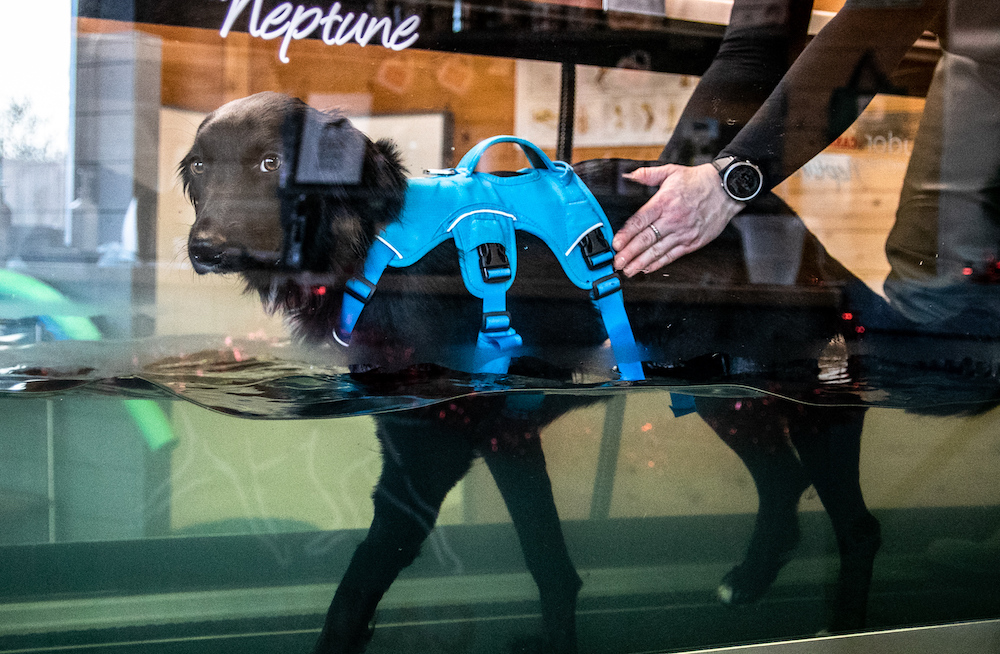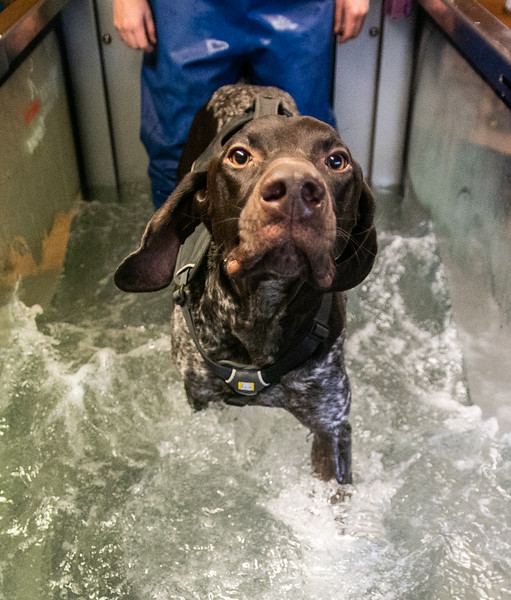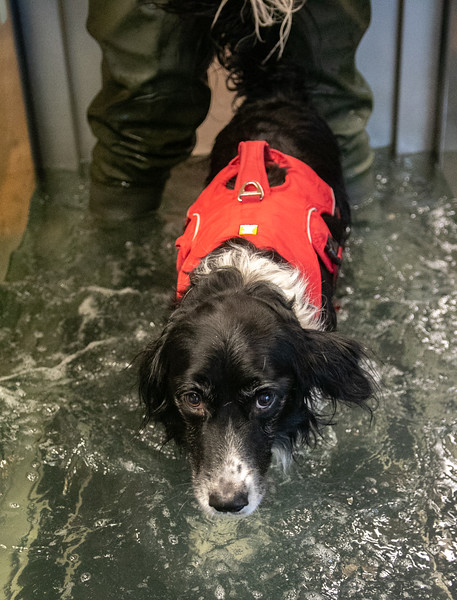
Why use Hydrotherapy for rehabilitation and fitness?
Hydrotherapy is the use of water to help with the healing of injuries in the body and has been used since ancient times. The word hydrotherapy actually comes from the Greek word for water healing because water offers a zero weight-bearing, or controlled weight-bearing way in which to exercise muscles and joints.
As a therapy, hydrotherapy has no or low force impact on the body and can be very beneficial as long as the water is heated and cleanliness is properly controlled with the use of chemicals.
Hydrotherapy can be extremely valuable for dogs recovering from injury or surgery, due to the low impact on the body of exercising in water. The weight-bearing property of water provides a supportive environment for a dog in order to gain a better range of movement.
Hydrotherapy can also be beneficial for dogs looking to lose weight, build muscle or to injury-proof sports dogs through targeted exercise in water. In the water, dogs can strengthen deep core muscles not usually activated through land-based activities. Given all the research and data currently available, the underwater treadmill is generally considered better for fitness in canine patients rather than the pool (Prankel, 2008).
The Properties of water, known for helping with the rehabilitation process are as follows:

- Resistance & Turbulence – Used to improve cardiovascular fitness, muscle strength and development.
- Muscle tone, muscle relaxation and joint mobility are all examples of things which hydrotherapy can be used to help with and by using hydrotherapy owners can see an increase in strength, endurance and muscle mass in their dogs. Pressure can be taken off joints, bones and muscles, therefore, relieving pressure and pain from these areas (Nganvongpanit and Yano, 2012).

- Buoyancy – Helps to stabilise a patient which is useful for weak patients and those who need less weight-bearing due to pain in any condition.
- Hydrostatic Pressure – Studies have shown venous return and swelling can be improved by the massaging effect which is being caused by the pressure (Prankel, 2008; Brundell, 2011). Pain can also be reduced, circulation and cell metabolism improved, all through the hydrostatic pressure of the water.
- Viscosity – Known to improve reaction times in dogs due to increased sensory feedback through skin receptors, also known as proprioception. This can be extremely useful if your dog has suffered any nerve damage, as water stimulates the skin.
- Cohesion – Can increase proprioception and increase the range of movement in the dog (as with viscosity). In practice, this means that the animal will have the most difficulty lifting and re-immersing its limb in the water when breaking surface tension. When incorporated into training, the results shown in the animal will be an increased range of motion at a joint. This can be encouraged by setting water levels around an inch below the target joint. (Calvo, 2018)
Hydrotherapy can also utilise the following properties of water to help your dogs' fitness goals and improve sports performance:
- Resistance & Turbulence – To improve cardiovascular fitness, muscle strength and development. Research has shown that shallow immersion creates greater muscle activity, relative to dry land exercise (Torres-Ronda, 2014).
- Hydrostatic Pressure – Can improve circulation and cell metabolism, great for encouraging muscle healing following hard physical work. It has also been shown that through the use of deeper water and compression of the chest wall, pulmonary function is changed to allow an increase in the work of breathing (Torres-Ronda, 2014).
“The weight bearing property of water provides a supportive environment for a dog in order to gain a better range of movement.”
- Viscosity & Cohesion – Known to increase the sensory awareness and reaction times in the dog through increased sensory feedback, also known as proprioception. The effects of the viscosity of water within training can result in a higher depth of coordination and motor control (King, 2016).
- Water Depth – When travelling at a higher speed through water, the force required by the muscles is proportionally higher when compared to walking. This allows the possibility of high-speed resistance training where joint impact does not need to be considered. (Torres-Ronda, 2014)
- Hydrotherapy can also be used to help reduce swelling and stiffness after a sports session (Brundell, 2011), increasing ability to train at a high level in subsequent sessions

For competing canine athletes such as sled dogs and pastoral dogs preventative conditioning and avoiding deconditioning is really important (Steiss, 2002) (Levine, Marcellin-Little and Taylor, 2005). Conditioning through hydrotherapy then avoids or minimises the risk of injuries such as muscle disorders (Steiss, 2002). Hydrotherapy can help provide additional benefits from conditioning such as lower resting heart rate, and blood pressure, stiffer cartilage and ligament, stronger bones, muscles and tendons, and increased stroke volume (Levine, Marcellin-Little and Taylor, 2005).

As you can see hydrotherapy can be used for injury rehabilitation, chronic illness support, fitness, conditioning, weight loss and to improve sports performance in dogs through a carefully tailored approach, individual to each dog, using the benefits the different properties of water can provide.
When selecting a hydrotherapy centre for your dog, don’t be afraid to ask for the hydrotherapist’s qualifications and also what the intended programme is for your dog. Every professional centre should be able to provide you with the reasons for their approach and explain how the session will be of benefit. With regular hydrotherapy sessions you should see improvements in your dogs’ muscle condition, gait and range of motion as the therapy starts to have an impact and this can be monitored in a number of different ways by the centre.
If you are considering taking your dog for hydrotherapy you will need a veterinary consent form signed by your vet. This is to ensure your vet is happy that your dog will benefit from the therapy and also to check that there are no contraindications for the hydrotherapy as a treatment. If your dog has multiple medical conditions it may be that hydrotherapy is not suitable but in most cases the benefits of hydrotherapy can be enjoyed with no risk to your dog and even dogs who do not usually like water, learn to be comfortable and happy in the sessions.
Our Expert
Written by Emily Thomas, Canine Hydrotherapist, Member of the Institute of Canine Hydrotherapists (ICH) part of the Institute of Registered Veterinary and Animal Physiotherapists and Director of the Canactive Hydrotherapy Centre and K9 Trail Time Ltd.
At the Canactive centre, every session is tailored to the individual dog to take into account the dogs’ needs for rehabilitation and different breeds, sports and owner goals for their dog for fitness, weight loss sports conditioning and performance.
For more information www.canactive.co.uk
